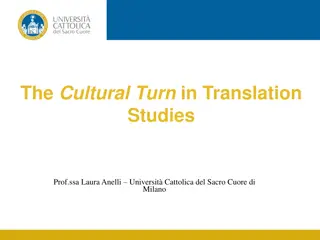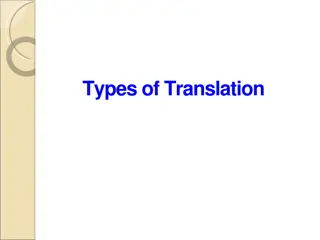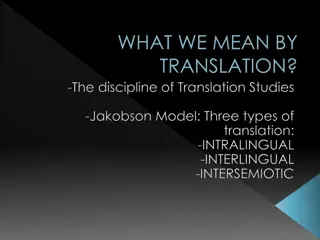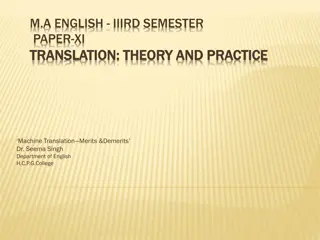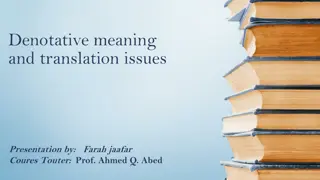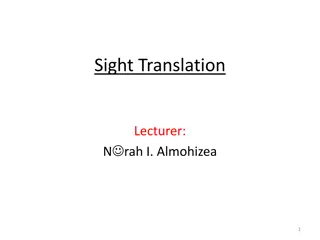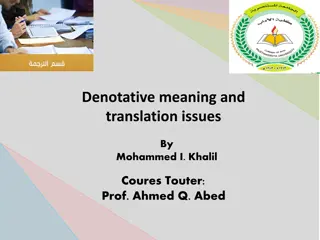Understanding Denotative Meaning and Translation Issues
Denotative meaning in translation poses challenges due to the elastic and indeterminate nature of meaning, especially in dealing with the cognitive or literal sense of words. Polysemy, homonymy, and synonymy contribute to complexities in determining precise denotative meanings. The rigidity and flexibility of denotative meanings in texts further complicate translation tasks. The categories by which language divides communicable experience play a significant role in defining denotative meanings.
Download Presentation

Please find below an Image/Link to download the presentation.
The content on the website is provided AS IS for your information and personal use only. It may not be sold, licensed, or shared on other websites without obtaining consent from the author. Download presentation by click this link. If you encounter any issues during the download, it is possible that the publisher has removed the file from their server.
E N D
Presentation Transcript
Denotative meaning and translation issues Presented by: Maryam Wissam and Ayat Amer
Denotative meaning Translation is concerned with meaning. But, as has already become very clear, the term meaning is elastic and indeterminate, especially when applied to a whole text. This is true even of denotative meaning (also known as cognitive, propositional or literal meaning). Denotative meaning is that kind of meaning that relates directly to the range of things that are conventionally referred to by a word or phrase in a particular sense. the fact that window by convention refers to a particular kind of aperture in a wall or roof is a matter of denotative meaning. 2
Denotative meaning The situation in which a word has more than one different and distinct denotative meaning or, more technically, more than one sense is known as polysemy. Polysemy can be illustrated by the word plain, which means (i) clear (as in a plain sky ), (ii) unadorned (as in a plain paper bag ) and (iii) obvious (as in it s a plain case of forgery ). There are sometimes problems in deciding between cases where two uses of a word represent more than one sense that is, cases of polysemy and where the two uses in question are merely variants of a single overall sense. here are also problems in deciding between what constitutes two senses of a single word and cases where two words happen to sound the same. This latter situation is known as homonymy. An example of homonymy that is fairly frequently quoted is bank = side of a river versus bank = institution for the investment and borrowing of money . A large proportion of a language s vocabulary is traditionally regarded as polysemous (or polysemic). Typically, dictionaries list polysemous words under single heads, separating what they regard as the distinct senses of a word by a semicolon and what are regarded as merely variants of a single sense by a comma (the Hans Wehr Dictionary of Modern Written Arabic and the Oxford Arabic Dictionary, for example, both do this). 3
Denotative meaning Due to two factors, it is difficult to determine the precise denotative meaning in any text: I. Because they impose, by abstraction and crystallization of one core sense (in the case of non-polysemous, or monosemous words) or a series of core senses (in the case of polysemous words), a rigidity of meaning that words do not often show in reality. In addition, once words are put into a context, their denotative meanings become even more flexible. II. The more literary the text, the more this is so; but it is true even of the most soberly informative texts. 4
1 Synonymy 5
Synonymy Denotative meaning is a matter of categories into which a language divides the totality of communicable experience. So, for example, the denotative meaning of the word pencil (in the relevant sense) consists of the fact that all over the world one may find similar objects that are included in the category of pencil and of course all sorts of other objects that are excluded from it. To define a denotative meaning is to specify a range covered by a word or phrase (in the relevant sense) in such a way that one knows what items are included in that range or category and what items are excluded. It is helpful to visualize denotative meanings as rectangles, because rectangles can represent intersections between categories. In exploring correspondence between denotative meanings, it is these intersections that are most significant, because they provide a kind of measure of semantic equivalence. So, for instance, the expressions my mother s father and my maternal grandfather may be represented as two separate rectangles. The two ranges of denotative meaning, however, coincide perfectly: that is, in every specific instance of use, my mother s father and my maternal grandfather include and exclude exactly the same referents. This can be visualized as sliding the two rectangles on top of each other and finding that they are the same size and cover each other exactly.
Synonymy Comparison of denotative meanings can also be made among expressions from two or more different languages. For example, maternal uncle and word ) in one sense of the ( cover exactly the same range of meanings and are therefore fully synonymous. my mother's father my maternal grandmother my mother's father my maternal grandmother Synonymy in English. maternal uncle Synonymy across English and Arabic maternal uncle 7
Hyperonymy- hyponymy Unfortunately, full synonymy is exceptional, both intralingually and interlingually. Even the nearest semantic equivalent for translating the denotative meaning of an ST expression usually falls short of being a full TL synonym. A simple example of this kind of failure is provided by a comparison between uncle in English and and in Arabic. Here, the English term uncle might be a typical translation equivalent of the Arabic or in English lacks the technical associations of paternal uncle and maternal uncle and would therefore be preferred in many contexts in translating or translation loss involved. From the point of view of denotative meaning, however, uncle has a greater range of meanings than or maternal uncle. Uncle ; uncle , regardless of the , as uncle includes both paternal uncle and 8
The relationship between uncle and and between uncle and is known as hyperonymy-hyponymy. An expression with a wider, less specific range of denotative meaning is a hyperonym (or superordinate) of one with a narrower and more specific meaning. Conversely, an expression with a narrower, more specific range of denotative meaning is a hyponym of one with a wider meaning. Thus and are both hyponyms of uncle . Hyperonymy-hyponymy is so widespread in all languages that one can say that the entire fabric of linguistic reference is built on such relationships. The same external reality can be described and rephrased in an indefinite number of ways, depending on how precise or vague one wants to be compare I bought a Hans Wehr with these increasingly general rephrasings : I bought an Arabic dictionary , I bought a dictionary , I bought a book , I bought something . Each of these rephrasings is a hyperonym of the ones before it. By its very nature, translation is concerned with rephrasing in such a way as to lose as little as possible of the integrity of an ST message. All other things being equal, this includes its degree of precision or vagueness. Therefore, the fact that both a hyperonym and a hyponym can serve for conveying a given message is of great importance to translation practice. It means that when there is no full TL synonym for a given ST expression (e.g. uncle ), the translator must look for an appropriate TL hyperonym or hyponym. In fact, translators do this automatically. This is obvious from the translation of pronouns between Arabic and English. English has one second-person pronoun you , which serves to address one, two or more people or animals. English you also makes no distinction between the sex of the person or animal being addressed Arabic has five second-person pronouns: feminine. , , , and , involving distinctions between singular, dual and plural, as well as masculine and 9
Particularizing translation and generalizing translation
Particularizing translation and generalizing translation Translating by a hyponym implies that the TT expression has a narrower and more specific denotative meaning than the ST expression. TT is more specific than ST uncle , adding particulars not present in the ST expression. We shall call this particularizing translation , or particularization for short. Another example of particularizing translation is the translation could be used for either a box or a bin . In the case of a street sweeper putting his rubbish into a plausible translation would be bin , while in the case of someone packing their books up to move them, the more plausible translation would be box . Translating by a hyperonym implies that the TT expression has a wider and less specific denotative meaning than the ST expression. In translating from Arabic to English, TT uncle is more general than ST particulars given by the ST. We shall call this generalizing translation , or generalization for short. Translating as garment or as pipe are other examples of generalization. , which , the more ) or , ( omitting 11
Particularizing In their semantic near-equivalence, particularization and generalization both entail a degree of translation loss: detail is either added to, or omitted from, the ST text. However, in the absence of plausible synonyms, translating by a hyponym or hyperonym is standard practice and entirely unremarkable. Only when a TL hyponym or hyperonym is unnecessary, contextually inappropriate or misleading can a TT be criticized in this respect. Particularizing translation is acceptable if the TL offers no suitable alternative and if the added detail does not clash with the overall context of the ST or the TT. Thus, in Arabic means country, town, city, place, community, village (Wehr). There is no single word in English that covers all of these possibilities; therefore, in a particular context, the translator is likely to have to choose the one that he or she feels is most appropriate. Other situations in which particularization is acceptable include the follow: 12
I. where the context implies something that is typically referred to in more specific terms in the TL than in the SL; thus, an issued by a military commander is likely to be an ultimatum rather than simply a warning ; a in a similar context is likely to be a proclamation or a communique rather than a statement ; in the context of NATO raids on Kosovo is likely to be strikes or air strikes rather than attacks . where the TL typically makes use of a specific collocation that happens to involve a hyponym of the TL form; for example, priceless treasure is the more common collocation in English. Particularizing translation may also be used for other reasons. For example, ancient church in a particular context where this was appropriate to avoid the ambiguity of old church , as this latter could be interpreted to mean former church instead of the intended old [= not new] church . That is to say, old in English is polysemous between the two senses of not new and former , and in this context, it would not necessarily be clear to the reader which of the two senses was intended. II. is likely to be translated as priceless treasure rather than as valuable treasure , as might be translated as Particularizing translation is not acceptable if the TL does in fact offer a suitable alternative to the additional detail or if the added detail clashes with the overall context of ST or TT. 13
Generalizing Generalization is acceptable if the TL offers no suitable alternative and the omitted detail is either unimportant in the ST or is implied in the TT context. For instance, Arabic refers only to something, such as a film or story, that makes one feel sad. In this it contrasts with (or even to some non-human entity, such as an animal), who is sad (i.e. who feels sad), or it may refer to something, such as a story or film, that makes one feel sad. In English, the word sad covers both possibilities: a sad person , a sad story . Typically, there is unlikely to be any confusion in translating as sad , and this is likely to be the most natural-sounding translation in most cases. As the examples a sad person and a sad story suggest, normally the context makes immediately plain in English whether what is intended is a feeling sad or a making sad interpretation. , which may refer to a person 14
Other situations in which generalization is acceptable include I. where the context implies something that is typically referred to in more specific terms in the SL than in the TL. For instance, it is common to refer to a room as in Arabic to mean not just that it is small but that it is rather too small. In many contexts in English, however, a suitable translation of translation, such as cramped room , being reserved for contexts in which it was important to stress that the room was too small. Similarly, in Arabic is regularly used to refer to any small bird. In translating the phrase speaking what is being meant is a specific small member of the class of small birds (i.e. a bird that is small even among small birds). where the TL typically makes use of a specific collocation that involves a hyperonym of the SL form. For instance, the first moment . However, in English, the normal phrase is for the first time . Similarly, means old and worn out clothes. However, in many contexts, would be happily translatable by the standard collocation old clothes would be the generalizing small room , a particularizing , it is likely to be sufficient to say small bird , although properly II. denotatively means for 15
Generalizing ]. . .[ This has been translated (Ives 1999:11) as: Whatever the legal problems linked to NATO intervention, to which I myself have recently referred [. . .] Here, the generalizing form recently is preferred to the denotative equivalent a few days ago mainly because it results in a less wordy overall phrase. Recently also allows the translator to use the present perfect have . . . referred , which adds a sense of immediacy and relevance to the statement; a few days ago would require the use of the simple past referred , which suggests more detachment. Generalizing translation is not acceptable if the TL does offer suitable alternatives or if the omitted details are important in the ST but not implied or compensated for in the TT context. Thus, in a context where it is important that the reader identifies the referent of you as a particular individual (i.e. singular you ), and not, for example, as a group of people (i.e. plural you ), it may be appropriate to compensate for the fact that English you subsumes both singular and plural by adding a noun that specifically identifies the person referred to 16
Generalizing Generalization is acceptable if the TL offers no suitable alternative and the omitted detail is either unimportant in the ST or is implied in the TT context. For , instance Arabic are both words for cooking pot , the difference being that refers to something bigger than purposes into English, however, the distinction could probably be ignored, and cooking pot would be a sufficient translation. Generalizing translation is not acceptable if the TL offers suitable alternatives or if the omitted details are important in the ST but not implied or compensated for in the TT context. and in Sudanese . For most translation 17
Semantic overlap and overlapping translation Semantic overlap and overlapping translation 18
There is a third degree of semantic equivalence. Consider the following: This has been translated as: The distinguished British writer Robert Fisk recently described a concert in Belgrade. Here, the meaning of overlaps with that of concert . Some concerts are examples of there are singing. Similarly, some cases of are examples of concerts; those that are organized in a formal way with musical players and audience. However, some concerts are not examples of singing. Similarly, some cases of are not examples of concerts; those, for example, in which the is not organized in a formal way with musical players and audience. That is, concert as a translation of generalizes by going beyond the idea of singing to include the possibility of music without song; but at the same time it particularizes by excluding the non-organized form of party , which is a possible interpretation of ]. . .[ ; those in which ; those in which there is no partially overlapping translation, or partial overlap for short , is common and often unavoidable. It can apply to single words as well as to phrases or whole sentences. If, in a given context, is translated as lecturer , not teacher , the TT certainly keeps the reference to someone who instructs. But it also particularizes, because it adds the specific detail that she works in a university and not in a school; and at the same time it generalizes, because it omits detail of her gender. 19
When the TL offers no suitable alternatives, partial overlap is acceptable if the omitted detail is unimportant or is implied in the overall TT context and if the added detail does not clash with the overall ST or TT contexts. Translating as lecturer or teacher , for example, will depending on context normally be as harmless as it is unavoidable. The typical uses of partially overlapping translation parallel those of particularizing translation and generalizing translation. Thus, partially overlapping translation may be used where the context implies something that is typically referred to by a term in the TL whose denotative meaning overlaps with the denotative meaning of the SL term. For example, a poem by the Syrian poet contains the line Rolph 1995: 23) as They attacked her like a young sparrow until they killed her . here overlaps in meaning with young . Some but not all spring sparrows are young, and some but not all young sparrows are spring sparrows (one could have a sparrow that was, abnormally, born in summer). Spring sparrow , however, is a problematic phrase in English; it does not have a clear meaning, and there is nothing in this overall context to make the intended meaning clearer in the English. Sparrow also yields an unfortunate collocative clash with spring chicken , meaning most basically young chicken for eating (originally available only in spring) but most commonly found in phrases such as he s no spring chicken , where spring chicken is an idiom essentially meaning young ; cf. Section 8.6. Accordingly, the translator has chosen a more contextually acceptable overlapping expression. . This has been translated ( 20
Near-synonymy and translation 21
Near-synonymy is a case not of synonymy but of hyperonymy-hyponymy or semantic overlap, which comes near to being synonymy. Thus, in the situation of near-synonymy involving hyperonymy-hyponymy, typically entities (things, etc.) that can be referred to by a particular hyperonym can also be referred to by the hyponym. An example from English is thin versus skinny assuming the reasonableness of a statement such as She s thin but not skinny but not the reasonableness of a statement She s skinny but not thin . All skinny people are accordingly thin, but not all thin people are skinny. Thin is a hyperonym of skinny . However, there is a very significant overlap between thin and skinny such that thin people are typically also skinny. Thin and skinny can accordingly be regarded as near- synonyms in English. As the example of thin versus skinny shows, near-synonymy is a rather vague concept. It does not seem possible to say exactly how great the overlap between a hyperonym-hyponym pair has to be for them to qualify as near- synonyms (or how great the non-overlap has to be for them not to qualify as near-synonyms). Nearsynonym remains, however, a useful concept in translation analysis 22
An example of near-synonymy involving a hyperonym-hyponym pair in English>Arabic translation is translating Arabic as English angry . Arabic usage of reflects the definition of the colloquial usage of degree of sadness (i.e. sadly angry ). Arabic is thus technically a hyponym of English angry (as it excludes those cases of anger that do not also involve sadness). is, however, close enough to the meaning of angry to be considered a near-synonym of angry . , as understood in Egypt and Sudan at least (where the definition of the Standard , ( means not just angry but angry with a As with cases of near-synonyms involving hyperonymy-hyponymy, what is and is not near-synonymy involving semantic overlap is rather vague. We cannot be sure how much semantic overlap is required for two words (in a particular sense) to qualify as near-synonyms or how much semantic non-overlap there would need to be for them to qualify as not near-synonyms. Nonetheless, the notion of nearsynonymy is, as already stated, a useful one in practice. 23
Semantic repetition in Arabic
Semantic repetition is repetition of meaning. Most basically, this involves the use of two (or more) synonyms or near-synonyms. But it can also be extended to include hyperonym-hyponym pairs and words and phrases standing in an associative relationship. 25
Synonym and near- synonym repetition
Synonym and near-synonym repetition Arabic frequently makes use of repetition of synonyms or near-synonyms in a way that is not normally found in English. This kind of repetition is sometimes referred to as semantic repetition Two types of (near) synonym repetition : I. where the two words or phrases used have closely related but distinguishable meanings that is, they are near-synonyms; an example of this is investigation and analysis II. where the words or phrases used are fully synonymous or, at least in the context in which they are being used, there is no clear difference in meaning; an example of this is the doublet in the phrase continuing continuous manner. (Near-)synonym repetition may involve any of the major parts of speech: nouns, as in ; adjectives, as in ; surprise and baffle in the phrase surprised and baffled him ); and adverbs, for instance, dispiritedly in the phrase (saw he the same woman walking silently and dispiritly. , literally, in a verbs, for instance, literally, her look ) silently and 27
Techniques to translate (near) synonym repetition A second fairly common technique, and one that is used where the two words in the (near-)synonym repetition have clearly different meanings, is to employ at least partial grammatical transposition. So the phrase might be translated as the collapse of all moral values . Here, the noun doublet of the Arabic has been replaced by an adjective noun phrase in English. The first of these is to merge the two Arabic words into one English word. This is particularly likely to be an appropriate strategy where there is no clear difference in meaning between the two Arabic words . So translated as severe measures (near- )synonym repetition of One final technique for translating (near)synonym repetition into English is to maintain the same form of repetition. An example of this is as this savage and barbaric behaviour translatable may be , 28
Synonym and near-synonym repetition (Near-)synonym repetition may be syndetic (i.e. it may involve the use of a connective, typically ( or in the case of adjectives in particular, but also occasionally in the case of nouns and verbs it may be asyndetic (i.e. it may occur without the use of a connective). An example of syndetic (near-)synonym repetition is phrase savage and barbaric behaviour . An example of asyndetic (near-)synonym repetition is , literally, pretty, elegant girls . in the in the phrase 29
The first technique that takes into account the potentially emphatic aspect of (near-)synonym repetition is what we shall call semantic distancing. This involves relaying both elements of the Arabic doublet by different words in English but choosing English words whose meanings are more obviously distinct than those of their Arabic counterparts. For example, in been translated ( St John 1999: 5), however, as Her appearance had both astonished and alarmed him ; the semantic difference between astonish and alarm is greater than that between distancing ensures that the English translation does not involve what would otherwise be the stylistic oddity in English of having two words with virtually the same meaning conjoined with each other. , the two words and are quite close in meaning .The phrase has and . This semantic 30
Here, the repetition in English carries the same emphatic and more specifically emotive force as it does in Arabic. The convention that operates otherwise in English that words having much the same meaning are not conjoined is overridden. Something similar happens with respect to formulaic language, especially where this is of a religious or legal nature. The following is from an oath made by members of the Muslim Brotherhood to their first leader This might be translated as: [. . .] You have the right to our unquestioning obedience, complete trust and total confidence. This is the oath which we have taken and the pledge which we have made . Here, the (near-)synonym repetition of and the pledge we have made is retained in the English and even expanded as the oath we have taken , 31
Hyperonym-hyponym repetition
Hyperonym- hyponym repetition Not only are synonyms and near-synonyms in Arabic repeated in ways that are unusual in English, but it is also fairly common in Arabic for a hyperonym to be followed by its hyponym in a way that appears to an English speaker to result in a semantic anomaly. Consider the following from the short story This might be translated fairly literally as: They don t talk to anyone, but they joke with the sellers and the barrow-men. Here, men. In cases such as this, the meaning of the first word in the particular context has to be taken as excluding that of the second word. In this context, therefore, has to be interpreted as meaning not sellers in general but that group of sellers who are not sellers and could be translated idiomatically as something like shopkeepers , giving an overall idiomatic translation along the lines: They don t talk to anyone, but they joke with the shopkeepers and the barrow-men } { } { .. the sellers is a hyperonym of barrow-men ,all barrow-men are sellers but not all sellers are barrow- the barrow men . Accordingly, here means the non-barrow-men 33
The following example is taken from the Quran (Chapter 2, Verse 238): This could be translated literally as: Keep your prayers and the middle prayer [. . .} A more idiomatic translation ( Yusuf Ali 1938) reads: Guard strictly your (habit of) prayers, especially the Middle Prayer [. . .] Here, is a hyponym of middle prayer would seem to suggest that the middle prayer is somehow not a prayer . Ali s translation prayers, especially the Middle Prayer avoids this with the introduction of especially It is, however, possible to find cases in which the hyponym comes first, ) appearing in the plural form (. A literal translation prayers and the } { { } } { { In this context, is effectively a hyponym and a hyperonym. That is to say, what is meant by neighbors' in this context is the neighboring states; and because all neighboring states are states of the world this looks like a hyponym-hyperonym relationship. TT TT: The identity of Iran and the nature of its relations with its neighbors and other states of the world. The identity of Iran and the nature of its relations with its neighbors and other states of the world. 34
Associative repetition
Associative repetition Associative repetition involves at least two or more elements, one of which is a basic element and the other, or others, of which are associated with that element. An example is ship and crew of a ship . Crew of a ship is not a type of ship , nor is it a part of a ship , this would be meronymic that is, part whole relationship . An associative relationship does, however, bear some similarity to the figure of speech of metonymy . This is (A figure of speech characterized by) the action of substituting for a word or phrase denoting an object, action, institution, etc., a word or phrase denoting a property or something associated with it; an instance of this (Oxford English Dictionary Online). 36
List restructuring
List restructuring One particularly striking feature in Arabic is a tendency to use fairly long lists of terms belonging to the same semantic field a semantic field being a general, normally rather impressionistically defined, area of meaning. In some contexts, an appropriate strategy in translating long lists into English is simply to reduce the listed elements. Thus, ties of blood and marriage would in many contexts be a sufficient translation of Because English does not so readily use exemplification through listing to suggest an overall scene or situation as does Arabic, it is sometimes appropriate when translating into English to insert a summary phrase, even when it seems reasonable to retain all or most of the elements of the original Arabic list. Consider the following, which is taken from an account of the internal leadership elections of the Phalange ( ( party in Lebanon in 1999: 38
List restructuring This has been translated ( Jones 1999: 8) as follows The ghost of 1992 was present in force, with {countless meetings} taking place in any available space: {on the balconies, in side offices, and even on the outside stairs} The Arabic ST here has two lists: [ in summarized is these of first The. English as countless meetings , while the second is retained in full .However, before the second list in the English, the translator inserted the additional summarizing phrase in every available space . } { } { ] and 39





